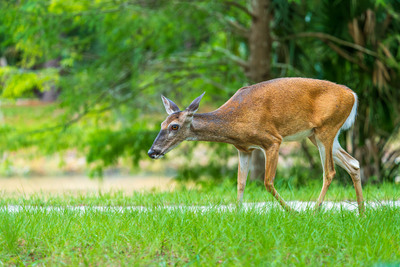Looking for design inspiration? Browse our curated collections!
March 16th, 2024 - 10:52 PM

**Respecting and Protecting Florida's White-Tailed Deer: A Call to Responsible Wildlife Interaction**
For many residents and visitors in Florida, encountering white-tailed deer is a cherished experience. These graceful creatures, with their gentle demeanor and striking appearance, often captivate the hearts of those fortunate enough to observe them in their natural habitat. However, as enchanting as these encounters may be, it's crucial to understand the importance of respecting and protecting these majestic animals, particularly in residential areas where human-wildlife interactions are common.
**The Beauty of White-Tailed Deer**
Deer are a common sight for many people and are beautiful to watch. With their elegant movements and striking features, they effortlessly blend into Florida's diverse landscape. White-tailed deer are primarily browsers, meaning they feed on leaves, shoots, flowers, and fruits of various plants. Their long, slender legs and tan-to-red-brown coloration allow them to move gracefully through forests, marshes, and even suburban neighborhoods.
One of the most distinctive features of white-tailed deer is their namesake tail, which is brown on top and white underneath. This feature becomes particularly noticeable when they are alarmed, as they wave their tails back and forth like a white flag, warning other deer of potential danger. Additionally, their large ears swivel attentively to detect the slightest sound of approaching predators, showcasing their keen sense of awareness.
**The Importance of Responsible Interaction**
While the allure of interacting with white-tailed deer may be tempting, it's essential to prioritize their well-being and safety above our own desires. Feeding deer in residential areas can be dangerous for both humans and the animals themselves. Not only does it disrupt their natural foraging behaviors, but it also increases the likelihood of conflicts between deer and humans, such as vehicle collisions and property damage.
Furthermore, interfering with fawns can have detrimental consequences. Unlike their adult counterparts, fawns have no scent, and their mothers limit contact with them to protect them from predators. If you encounter a fawn, it's best to leave it alone, as its mother is likely nearby, monitoring from a safe distance. Disturbing or attempting to handle the fawn can disrupt this crucial bonding process and may ultimately endanger its survival.
**Promoting Coexistence Through Observation**
To truly respect and protect white-tailed deer, we must prioritize observation over interaction. By observing these magnificent creatures from a respectful distance, we can appreciate their beauty without compromising their safety or well-being.
One of the best ways to do this is through wildlife photography using a zoom lens, or by using binoculars.
Remember that deer are most active during dawn and dusk, so these times present excellent opportunities for quiet observation from a distance.
It's also important to recognize the signs of deer behavior. When deer are nervous or alarmed, they may stomp a foot and emit a snort before swiftly retreating to safety. By understanding and respecting these cues, we can avoid inadvertently causing distress to these sensitive animals.
**Conclusion**
In conclusion, respecting and protecting Florida's white-tailed deer is not only a matter of conservation but also a responsibility that we owe to the natural world. By refraining from feeding deer, avoiding unnecessary interactions with fawns, and observing these animals from a respectful distance, we can foster a harmonious coexistence between humans and wildlife.
As stewards of the environment, let us embrace the beauty of these magnificent creatures while recognizing the importance of preserving their natural behaviors and habitats. Together, we can ensure that future generations will continue to marvel at the sight of white-tailed deer roaming freely in Florida's landscapes, a testament to our commitment to wildlife conservation and responsible stewardship.
Comments
There are no comments on this blog. Click here to post the first comment.